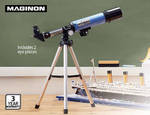This may not be the cheapest way to see uranus but it is pretty good.
Great present for that nerdy kid. Good price too. Usually these a $50+ at bigger stores.
Have fun discovering new planets.
- Ideal for land and sky observations
- 18x, 27x, 60x and 90x magnification
- 1.5x erecting lens magnification
- Includes an aluminium tripod, 2 eye pieces and a storage case


Cheap or not, don't waste your money on this.
Apart from spying on neighbours you won't be able to see much in the sky… definitely not uranus :-)